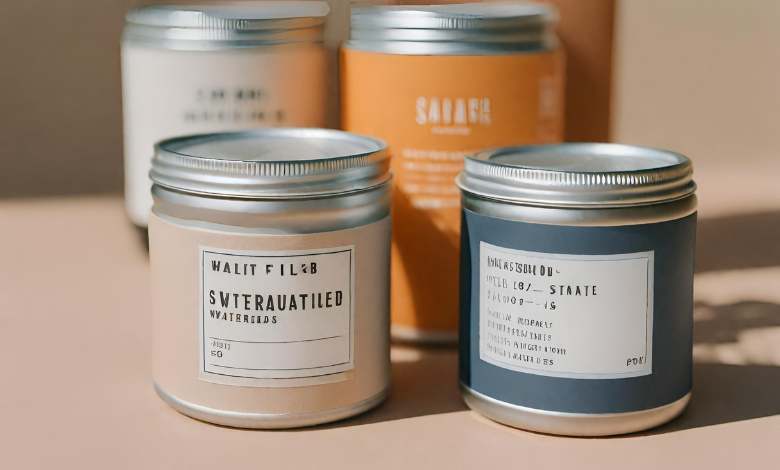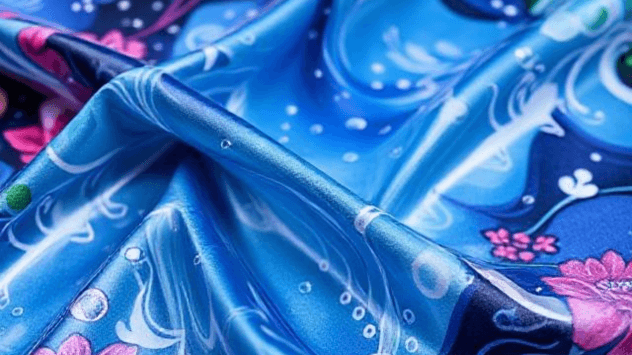 If you’re wondering how to make waterproof labels, we have a comprehensive guide that provides step-by-step instructions. Do you need labels that will not smear or peel when exposed to water? Whether you’re labeling bottles, jars, or other products, making waterproof labels is essential for durability and longevity. We will teach you how to make your labels waterproof in this in-depth guide so they stay intact and readable in any setting.
If you’re wondering how to make waterproof labels, we have a comprehensive guide that provides step-by-step instructions. Do you need labels that will not smear or peel when exposed to water? Whether you’re labeling bottles, jars, or other products, making waterproof labels is essential for durability and longevity. We will teach you how to make your labels waterproof in this in-depth guide so they stay intact and readable in any setting.
-
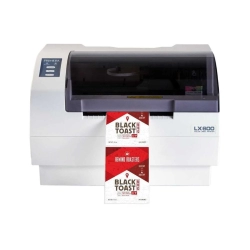 Primera LX600 Color Label Printer SKU: LX600$1,995.00
Primera LX600 Color Label Printer SKU: LX600$1,995.00
FREE SHIPPING over $199*
Orders before 12PM EST usually Ship Same Business Day -
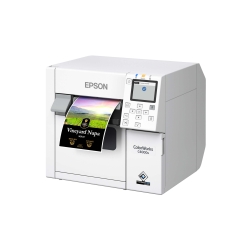 Epson C4000 / CW-C4000 ColorWorks Inkjet Label Printer (Gloss) SKU: C31CK03A9991$2,419.00
Epson C4000 / CW-C4000 ColorWorks Inkjet Label Printer (Gloss) SKU: C31CK03A9991$2,419.00
FREE SHIPPING over $199*
Orders before 12PM EST usually Ship Same Business Day -
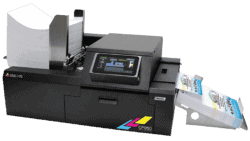 Afinia CP950 Envelope Packaging and Box Color Label Printer SKU: 35256$19,995.00
Afinia CP950 Envelope Packaging and Box Color Label Printer SKU: 35256$19,995.00
FREE SHIPPING over $199*
Orders before 12PM EST usually Ship Same Business Day
Waterproof Labels
Waterproof labels are indispensable in a variety of applications, particularly when the need arises to label bottles, jars, or products that may come into contact with moisture. To achieve impeccable waterproof label printing, specialized equipment is essential to ensure that the labels remain impeccably intact even when exposed to moisture. These labels are thoughtfully designed to repel water, safeguarding them against the loss of adhesive properties or becoming illegible when wet.
In the realm of label materials, there are options such as synthetic materials or those that are BS5609-certified, specifically crafted for waterproof or water-resistant applications. While it’s important to note that these labels aren’t entirely impervious to water damage, they exhibit superior resistance to prolonged exposure to moisture compared to standard paper labels. Consequently, they have garnered popularity within various industries, including frozen food, chemicals, pharmaceuticals, chilled beverages, and refrigerated food, where products are routinely subjected to moisture and water over extended periods. These labels represent an excellent choice for mitigating the effects of mild to moderate product moisture exposure.
However, when opting for BS5609-certified materials, it’s imperative to ensure that the chosen material aligns with the requirements of your printer. Non-compliance with these stringent standards could render the label ineffective in meeting the exact durability criteria set forth by BS5609. British Standard 5609 enjoys widespread recognition as one of the most rigorous testing protocols for printed labels and is esteemed within the label industry as a hallmark of label durability excellence.
Ink vs. Toner
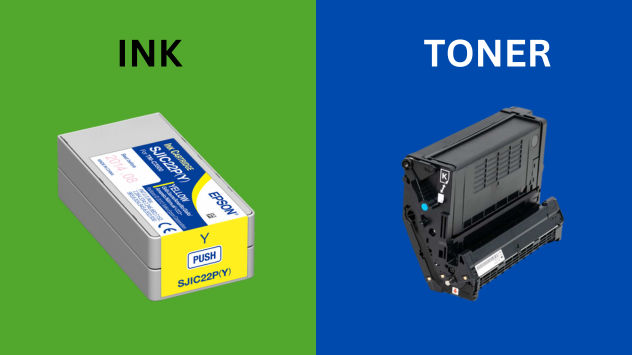
When it comes to the printing of labels, there is a notable distinction between ink and toner-based label printers. Toner-based label printers hold the unique distinction of being genuinely waterproof, primarily due to the fusion process that securely binds the toner to the label material. However, it’s worth noting that this advantage comes at a price, as toner-based printing tends to be more costly compared to inkjet label printing. Furthermore, even though prints made with toner are undoubtedly robust, their print quality might not always be as good as that of inkjet prints. Furthermore, toner-based printer maintenance expenses can be significantly greater.
On the other hand, inkjet label printers offer a cost-effective alternative with lower printing expenses. Nonetheless, it’s important to recognize that inkjet labels fall under the category of “water-resistant” rather than being completely waterproof. However, they demonstrate impressive resilience, often remaining unaffected for extended durations when exposed to demanding environmental conditions. For instance, numerous pigment-based inkjet label printers, certified in compliance with BS5609 standards, are capable of producing labels using BS5609-certified label materials that can endure months or even years in ocean saltwater without smudging or bleeding.
Practically speaking, inkjet label printers often demonstrate that they are more than capable of satisfying the waterproofing or water-resistance specifications that are required by the great majority of industries. This versatility makes them a viable and cost-efficient choice for a wide array of labeling applications.
Label Material
If you want to make sure that your labels are resistant to water, you should use synthetic materials like vinyl, polyester, or polypropylene (BOPP). These materials offer excellent water resistance compared to paper-based labels, which tend to dissolve when exposed to prolonged water contact. BS5609-certified label materials, known for their durability in aquatic environments, always incorporate synthetic elements like BOPP or polyester. In essence, selecting the right waterproof label material, such as vinyl, polyester, or polypropylene, is crucial to ensuring your labels remain intact even when submerged in water.
-
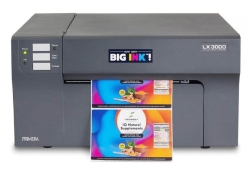 Primera LX3000 Color Label Printer with Big Ink, Pigment Ink SKU: LX3000-pigment$3,195.00
Primera LX3000 Color Label Printer with Big Ink, Pigment Ink SKU: LX3000-pigment$3,195.00
FREE SHIPPING over $199*
Orders before 12PM EST usually Ship Same Business Day -
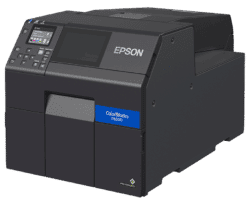 Epson ColorWorks CW-C6000A Matte Color Inkjet Label Printer with Auto Cutter SKU: C31CH76A9981$2,969.00
Epson ColorWorks CW-C6000A Matte Color Inkjet Label Printer with Auto Cutter SKU: C31CH76A9981$2,969.00
FREE SHIPPING over $199*
Orders before 12PM EST usually Ship Same Business Day -
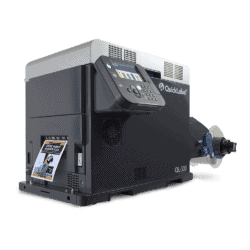 Quick Label QL-300 (120V) Toner CMYK Color Label Printer SKU: 1003-0000002$9,495.00
Quick Label QL-300 (120V) Toner CMYK Color Label Printer SKU: 1003-0000002$9,495.00
FREE SHIPPING over $199*
Orders before 12PM EST usually Ship Same Business Day
Lamination
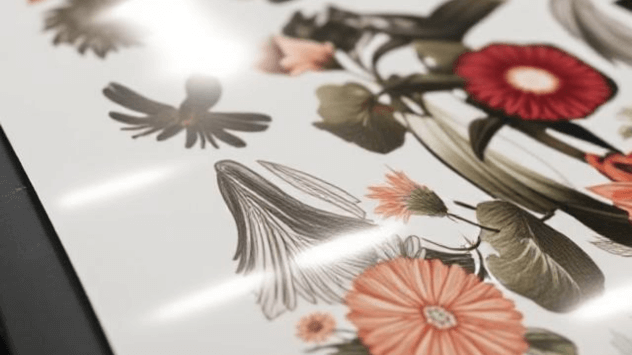
Taking waterproofing to the next level, lamination offers an enhanced layer of protection for your labels. Achieving this involves the utilization of a digital label finisher, a versatile machine capable of performing various functions, including lamination. In addition to laminating, these machines can roll, die-cut, slit, and remove matrices from your labels, providing comprehensive label finishing capabilities.
Lamination elevates the water resistance and abrasion resistance of your labels, ensuring their durability even under prolonged exposure to moisture. Typically composed of exceptionally durable polyester or other synthetic materials, laminates impart a premium appearance to paper labels, resembling expensive synthetic materials without the associated high costs. Consequently, laminated labels are a prudent choice for applications where labels may encounter moderate to severe moisture exposure.
Combination
Utilizing a blend of synthetic waterproof label materials in conjunction with a lamination process offers the ultimate in moisture resistance for your labels. This strategic pairing of waterproof labels and lamination guarantees that your labels remain both dry and legible, even when confronted with moisture-laden environments. For those seeking unparalleled water resistance, the integration of waterproof label materials with lamination proves exceptionally effective, rendering labels capable of enduring the most challenging conditions, making them ideal for outdoor or wet settings.
Can waterproof labels be printed at home?
Yes, it is possible to print waterproof labels at home. To do this, you must take the following actions:
1. Use Waterproof Materials:
Creating a waterproof label necessitates the use of waterproof materials for both the print medium and adhesive. Coating or finishing plant pulp-based print media can offer a degree of water resistance, but it may become compromised if the coating or finish is damaged.
Waterproof label materials, like plastic-based options suitable for labels and stickers, encompass materials such as polyester, polyethylene, polypropylene, PVC, or vinyl.
2. Use Waterproof Prints:
Tip #2 emphasizes the importance of using waterproof prints when creating waterproof labels. Various label printers, including inkjet, laser, direct thermal, and thermal transfer printers, are commonly used for this purpose.
Inkjet printers are generally not recommended for waterproof labels due to their low protection against water, as most inks are water-based and prone to smudging when wet. There are some exceptions, such as premium pigment-based and water-resistant inks.
Laser printers are a good choice for waterproof labels because they provide a mediocre level of water resistance. They use powder toners that do not wash out with water, making them suitable for this purpose.
Direct thermal printers utilize heat for printing, and while they resist fading in moisture, they are sensitive to extreme temperatures and friction. Additionally, they are not ideal for plastic-based media.
Thermal transfer printers combine heat and ribbons to print on media, offering high resistance to moisture. They print on synthetic-based media and are more robust than direct thermal printers.
For labels that require a high level of moisture protection, choosing a printing process like laser or thermal transfer is recommended, as they offer the most reliable defense against water. However, direct thermal printing may be suitable for specific applications, keeping in mind its vulnerability to temperature changes and limited compatibility with waterproof print media like plastic.
3. Use Waterproof Adhesive:
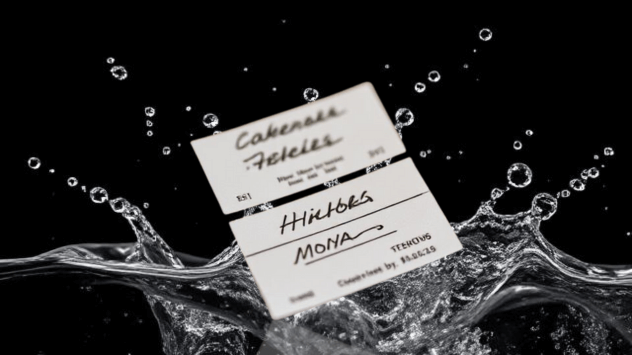
Tip #3 emphasizes the importance of using waterproof adhesive when creating waterproof labels. The choice of adhesive is crucial because it significantly impacts the label’s longevity and performance, especially in various environmental conditions and moisture exposure.
Specially formulated adhesives, often used in “permanent” adhesive labels, offer extended durability even in the presence of moisture. It’s important to note that no printing process is inherently waterproof, but selecting the right printing method can enhance the water resistance of your labels.
Creating truly waterproof labels involves a combination of elements, including using waterproof label materials and appropriate printing technology to safeguard your prints from moisture. Additionally, you can explore the application of a specialized coating or spray on your label media to achieve a waterproof finish, which will be further discussed in the following sections.
Making Labels That Are Waterproof
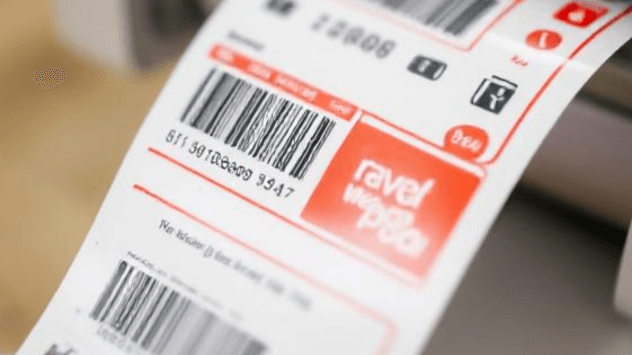
This article offers instructions for making labels waterproof, particularly if they are printed using an inkjet printer on paper made of wood pulp or water-resistant media and must withstand high moisture levels. If these apply to your labels, you may want to take the following actions to waterproof them:
-
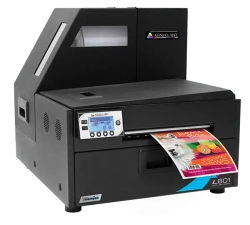 Afinia L801 Plus Commercial Color Label Printer SKU: 32498$8,995.00
Afinia L801 Plus Commercial Color Label Printer SKU: 32498$8,995.00
FREE SHIPPING over $199*
Orders before 12PM EST usually Ship Same Business Day -
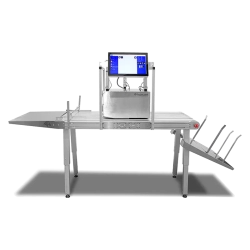 Trojan T3 OPX Over Printer Wide-Format Direct-to-Package Printing SKU: 43160000$26,330.00
Trojan T3 OPX Over Printer Wide-Format Direct-to-Package Printing SKU: 43160000$26,330.00
FREE SHIPPING over $199*
Orders before 12PM EST usually Ship Same Business Day -
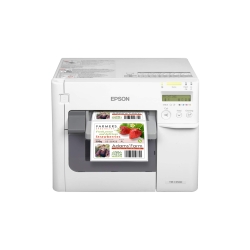 Epson ColorWorks C3500 Inkjet Color Label Printer SKU: C31CD54011 GTIN: 814420980046$2,419.00
Epson ColorWorks C3500 Inkjet Color Label Printer SKU: C31CD54011 GTIN: 814420980046$2,419.00
FREE SHIPPING over $199*
Orders before 12PM EST usually Ship Same Business Day
First step: Use a Clear Overcoat Spray
- Get a clear gloss overcoat spray that is waterproof.
- Make sure the print or ink has dried before printing your label on self-adhesive material.
- Trim your label of any extra paper or matrix.
- The label should be placed on a dry, clean surface.
- Shake the spray can and, working from a distance of about 10 inches, evenly apply the coating to the label surfaces.
- Following each sweep, shake the can.
- Let the label air dry.
- After removing the label, stick the sticker to a dry, clean surface.
Utilize a clear overlay sticker sheet in step two.
Option 1:
- Get a clear, self-sticking overcoat sheet that is just a little bit bigger than your labels and, if at all possible, in the same shape.
- Print your labels on any type of printable material, though self-stick labels work best.
- Let your labels dry so that any dust or debris is removed from the label’s surface.
- Evenly apply the clear overcoat sheet to your label, making sure to eliminate any air bubbles.
- Using a cutter or, if applicable, a Cricut, cut the labels into the desired shape.
- Delay putting on the overcoat.
Option 2: Apply a film laminator
- After printing your labels, allow them to air dry.
- Trim the laminating film to the exact size of your label.
- For self-adhesive labels or stickers, place the laminating film over the label surface, making sure not to come into contact with the adhesive side.
- Apply a laminating machine to the sheets to seal them.
- Cut the label to the desired dimensions.
- Take off the label and place it on a dry, clean surface.
By following these steps, you can effectively waterproof your labels, ensuring their durability and performance, even in moisture-prone conditions.
Is it possible to create waterproof labels using an inkjet printer?
Waterproof? No. Highly water resistant, yes. Inkjet printers employ water-based inks, so the prints they produce are not entirely waterproof. To give water and other liquids more resistance, you can apply a coating, spray, or laser printer. Many pigment based inkjet inks are highly water resistant – as discussed above.
Choose the Label That Best Fits Your Needs
Water-resistant labels also provide the same protection against low moisture exposure, but they are less expensive. Determine which kind of labels best fit your needs based on your available funds. Many stores sell waterproof labels and stickers that meet transportation and storage marking regulations. Additionally, we provided instructions on how to create waterproof labels and stickers using a variety of materials that are typically found around the house or workplace.
-
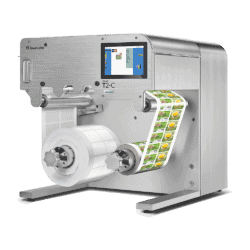 TrojanLabel T2-C Tabletop Volume Press Label Printer SKU: 10000155$33,995.00
TrojanLabel T2-C Tabletop Volume Press Label Printer SKU: 10000155$33,995.00
FREE SHIPPING over $199*
Orders before 12PM EST usually Ship Same Business Day -
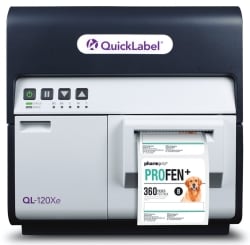 Quick Label QL-120Xe Inkjet Color Label Printer with 1 Year Warranty SKU: 42725300$5,995.00
Quick Label QL-120Xe Inkjet Color Label Printer with 1 Year Warranty SKU: 42725300$5,995.00
FREE SHIPPING over $199*
Orders before 12PM EST usually Ship Same Business Day -
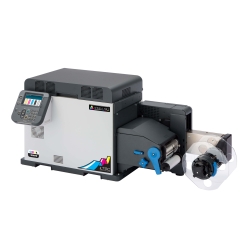 Afinia LT5C CMYK + White Label Printer SKU: 36138$13,350.00
Afinia LT5C CMYK + White Label Printer SKU: 36138$13,350.00
FREE SHIPPING over $199*
Orders before 12PM EST usually Ship Same Business Day
Conclusion
To sum it up, crafting waterproof labels is paramount to maintaining label integrity across diverse settings. Whether you opt for inkjet or laser toner printing, select the appropriate label material, implement lamination, or combine these techniques, you can guarantee the longevity and waterproof nature of your labels. Our printable waterproof labels are ideal for labeling bottles, ensuring they stay legible and attractive even when refrigerated. Investing in a waterproof label printer is a smart choice if you need to produce labels that can endure water exposure.
Are you searching for waterproof labels for bottles? Look no further; our high-quality labels are designed to withstand moisture and maintain their adhesive strength. If you’re seeking guidance on finding the best waterproof label printer or require further assistance with your labeling needs, TCS Digital Solutions is here to help. Feel free to reach out to us for expert advice and solutions tailored to your specific requirements.
Have any questions or would like to know more about waterproof labels and waterproof label printers? Contact us today; we’re here to help!
Related Articles


